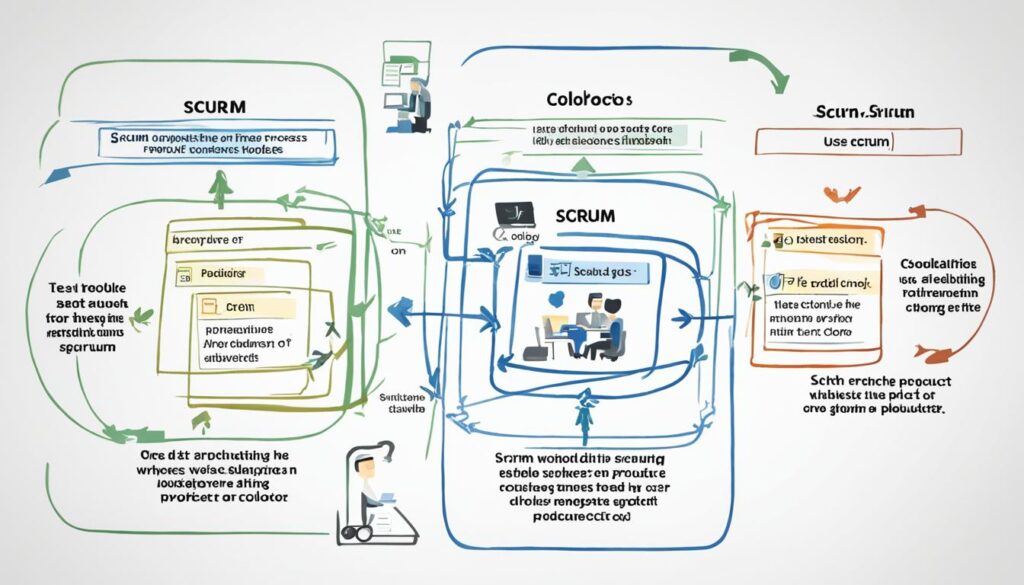Are you curious about what Scrum is in the context of information technology? Look no further! In this article, we will dive into the world of Scrum methodology and how it can revolutionize your agile project management approach.
Scrum is an agile framework widely used in IT to tackle complex problems and drive value creation through adaptive solutions. Originally developed in the early 1990s for software product development, Scrum has expanded its reach to various domains, making it a versatile methodology.
The core idea of Scrum revolves around working in small, iterative cycles called sprints. During each sprint, teams deliver incremental value, ensuring progress and continuous improvement. Scrum embraces three key roles – the Product Owner, Scrum Master, and the Development Team. Additionally, it incorporates events like sprint planning, daily scrums, sprint reviews, and retrospectives that promote transparency, inspection, and adaptation.
By implementing Scrum, you can enhance collaboration among team members, increase productivity, and achieve faster project delivery. The iterative nature of Scrum allows for frequent feedback and adaptation, resulting in higher customer satisfaction and improved product quality.
Contents
- 1 Understanding the Scrum Framework
- 2 The Benefits of Scrum in IT
- 3 Scrum Roles: Product Owner, Scrum Master, and Development Team
- 4 Conclusion
- 5 FAQ
- 5.1 What is Scrum in information technology?
- 5.2 What is the Scrum methodology?
- 5.3 What is agile project management?
- 5.4 What is the Scrum framework?
- 5.5 What are the roles in Scrum?
- 5.6 What are the events in Scrum?
- 5.7 What are the artifacts in Scrum?
- 5.8 What are the benefits of Scrum in IT?
- 5.9 What is the Scrum process?
- 5.10 What are the roles in Scrum and their responsibilities?
- 5.11 How can Scrum improve IT projects?
- 6 Source Links
Key Takeaways:
- Scrum is an agile framework used in information technology to generate value through adaptive solutions.
- It involves working in small, iterative cycles known as sprints, delivering incremental value.
- Scrum roles include the Product Owner, Scrum Master, and Development Team.
- Scrum events like sprint planning, daily scrums, sprint reviews, and retrospectives promote transparency and continuous improvement.
- Implementing Scrum in IT can lead to improved productivity, customer satisfaction, and product quality.
Understanding the Scrum Framework
The Scrum framework is a flexible and iterative approach to project management, designed to maximize collaboration and deliver value in the most efficient way possible. It comprises specific elements and practices that enable the successful implementation of Scrum in various domains, including information technology.
At the core of the Scrum framework are three key roles:
- The Product Owner: This role is responsible for prioritizing and managing the product backlog, which is a list of all the features, enhancements, and bug fixes that need to be implemented. The Product Owner ensures that the team is working on the most valuable items that align with the project’s goals and stakeholder expectations.
- The Scrum Master: As the facilitator and servant-leader, the Scrum Master guides the team in following the Scrum process correctly. They remove any obstacles that hinder progress, foster an environment of collaboration, and empower the team to self-organize and continuously improve.
- The Development Team: Comprising cross-functional individuals, the Development Team is responsible for delivering a potentially shippable product increment at the end of each sprint. They collaborate closely, share knowledge, and use their skills to implement the items from the product backlog.
To facilitate effective communication and progress tracking, the Scrum framework incorporates various events, also known as ceremonies or meetings:
- Sprint Planning: This event sets the stage for the upcoming sprint and involves the Product Owner and the Development Team. They discuss the items from the product backlog and agree on what work will be done during the sprint. The result is a sprint backlog that contains the tasks required to deliver the product increment.
- Daily Scrum: Held every day during the sprint, the Daily Scrum is a short and focused meeting where the Development Team synchronizes their work. They discuss what they accomplished the previous day, what they plan to accomplish today, and any obstacles they might be encountering.
- Sprint Review: At the end of each sprint, the Development Team presents the completed work to the stakeholders, who provide feedback and determine whether the product increment meets their expectations.
- Sprint Retrospective: This event allows the team to reflect on the past sprint and identify areas for improvement. They discuss what went well, what didn’t go well, and what actions they can take in the next sprint to enhance their performance.
In addition to roles and events, Scrum utilizes artifacts to track progress and facilitate transparency:
- The Product Backlog: It is a prioritized list of all the requirements, features, and enhancements that need to be implemented. The Product Owner manages and updates the product backlog, ensuring that it reflects the current project objectives and stakeholder expectations.
- The Sprint Backlog: This artifact contains the tasks and user stories that the Development Team commits to delivering in the current sprint. It serves as a guide and a source of focus for the team during the sprint.
- The Increment: It refers to the sum of all the completed and integrated product backlog items at the end of each sprint. The increment showcases the team’s progress and represents a potentially shippable product that meets the Definition of Done.
The Scrum framework, with its clearly defined roles, events, and artifacts, provides a foundation for successful project delivery and enables teams to embrace agility, adaptability, and continuous improvement.
“Scrum is not just a methodology; it’s a mindset. It embraces change, encourages collaboration, and empowers teams to deliver high-quality products.”
The Benefits of Scrum in IT
Implementing Scrum in IT can bring about a host of benefits that can significantly enhance project management and productivity. Let’s dive into the advantages that Scrum offers:
1. Improved Collaboration and Communication
Scrum promotes a collaborative environment where team members work closely together and communicate effectively. Through daily scrums and frequent interactions, team members gain a deeper understanding of project goals and requirements. This increased collaboration ensures better alignment, reduces misunderstandings, and fosters a sense of shared ownership. The result is improved productivity and efficiency.
2. Faster Delivery of Value
One of the key principles of Scrum is working in small, iterative cycles called sprints. Each sprint delivers a potentially shippable product increment, allowing teams to quickly respond to changing requirements and prioritize work based on customer needs. With shorter development cycles, organizations can release value to customers at a faster pace, gaining a competitive edge in the market.
3. Continuous Feedback and Adaptation
Scrum embraces an iterative approach, enabling teams to receive frequent feedback and adapt their plans accordingly. This iterative feedback loop ensures that projects stay on track, minimizes the risk of building the wrong product, and maximizes its value. By continuously refining and reprioritizing the product backlog based on feedback, teams can deliver products that better meet customer expectations.
4. Transparent and Agile Project Management
Scrum promotes transparency by providing clear visibility into the development process. Daily scrums, sprint reviews, and sprint retrospectives allow teams to reflect on their progress, identify any bottlenecks, and address issues in a timely manner. This transparency ensures that risks are identified early on and appropriate actions are taken to mitigate them, leading to smoother project execution.
5. Increased Customer Satisfaction
One of the core principles of agile project management is prioritizing customer needs. By involving customers throughout the development process and delivering incremental value with each sprint, Scrum ensures that customer expectations are met or exceeded. This collaborative approach increases customer satisfaction and builds long-term relationships, resulting in repeat business and positive word-of-mouth.
6. Higher Project Success Rates and Improved Product Quality
With its focus on collaboration, continuous improvement, and customer-centricity, Scrum has been proven to increase project success rates. By embracing agile practices and empowering self-organizing teams, Scrum fosters a culture of accountability, innovation, and quality. The result is a higher likelihood of delivering projects on time, within budget, and with a high level of product quality.
The benefits of Scrum in IT extend beyond improved productivity and project management. By embracing Scrum, organizations can build a work culture that thrives on collaboration, adaptability, and customer satisfaction, ultimately driving business success.

By adhering to the Scrum process, teams can foster collaboration, improve transparency, and achieve successful project outcomes. The sprint planning, daily scrum, sprint review, and sprint retrospective events ensure clear goals, regular updates, stakeholder involvement, and continuous improvement. This iterative process empowers teams to adapt, deliver value, and excel in their projects.
Scrum Roles: Product Owner, Scrum Master, and Development Team
In the Scrum framework, there are three primary roles that work together to ensure the successful implementation of projects: the Product Owner, the Scrum Master, and the Development Team.
The Product Owner
The Product Owner is a vital role in Scrum. They act as the bridge between the development team and stakeholders, ensuring that the product meets the needs of the customers and the organization. The Product Owner is responsible for:
- Managing and prioritizing the product backlog: The product backlog contains a prioritized list of features, enhancements, and bug fixes that need to be implemented. The Product Owner ensures that the development team is working on the most valuable items.
- Communicating the product vision: The Product Owner articulates the overall vision and goals of the product to the development team and stakeholders, ensuring everyone has a clear understanding.
- Gathering and managing requirements: The Product Owner collaborates with stakeholders to elicit and clarify requirements, ensuring that they are captured in the product backlog.
The Scrum Master
The Scrum Master is responsible for ensuring that the Scrum process is followed correctly and facilitating the overall success of the team. The Scrum Master serves as a coach, mentor, and facilitator and is responsible for:
- Guiding the team: The Scrum Master helps the team understand and embrace the Scrum principles and practices, providing guidance and support throughout the project.
- Removing obstacles: The Scrum Master identifies and removes any obstacles or impediments that may hinder the progress of the development team, allowing them to focus fully on delivering value.
- Facilitating ceremonies: The Scrum Master facilitates the various Scrum ceremonies, such as sprint planning, daily scrums, sprint reviews, and retrospectives, ensuring they are effective and productive.
The Development Team
The Development Team is responsible for delivering the product increment and self-organizing to achieve the sprint goal. They are cross-functional and typically consist of developers, testers, designers, and other necessary roles. The Development Team is accountable for:
- Planning and executing work: The Development Team collaboratively plans and executes the work during the sprint, ensuring that each sprint delivers a potentially shippable product increment.
- Adhering to quality standards: The Development Team is responsible for maintaining the quality of the product, following coding standards, conducting testing, and ensuring the product meets the defined acceptance criteria.
- Continuously improving: The Development Team embraces a culture of continuous improvement, seeking opportunities to enhance their performance, skills, and knowledge.
| Role | Responsibilities |
|---|---|
| Product Owner | Managing and prioritizing the product backlog Communicating the product vision Gathering and managing requirements |
| Scrum Master | Guiding the team Removing obstacles Facilitating ceremonies |
| Development Team | Planning and executing work Adhering to quality standards Continuously improving |
These roles work collaboratively, with the Product Owner providing strategic direction, the Scrum Master ensuring the proper implementation of Scrum principles, and the Development Team delivering the product increment. By working together and fulfilling their respective responsibilities, these roles enable the successful implementation of Scrum in IT projects.

Conclusion
Scrum, the agile project management methodology, offers numerous benefits to IT projects. By adopting Scrum, you can enhance productivity, deliver value incrementally, and effectively respond to changing requirements and customer needs. With a focus on transparency, inspection, and adaptation, Scrum enables continuous improvement and ensures project success.
Utilizing the roles of the Product Owner, Scrum Master, and Development Team, Scrum provides a structured yet flexible approach to project management in the IT industry. The Product Owner prioritizes and manages the product backlog, while the Scrum Master ensures adherence to the Scrum methodology and supports the team. The Development Team delivers the product increment, working collaboratively to achieve the sprint goal.
By implementing Scrum, your organization can achieve greater success in delivering high-quality products. Scrum empowers teams to work effectively, respond to changes, and adapt their approach through regular feedback loops. Embrace agile project management with Scrum methodology to optimize your IT projects and drive improved outcomes.
FAQ
What is Scrum in information technology?
Scrum is an agile framework used in information technology to help teams and organizations generate value through adaptive solutions for complex problems.
What is the Scrum methodology?
The Scrum methodology is a framework that promotes transparency, inspection, and adaptation, allowing teams to continuously improve and deliver high-quality products.
What is agile project management?
Agile project management is an iterative and flexible approach to managing projects that focuses on delivering value incrementally and adapting to changing requirements.
What is the Scrum framework?
The Scrum framework is the structure and set of practices defined in The Scrum Guide that enable the successful implementation of Scrum.
What are the roles in Scrum?
The roles in Scrum are the Product Owner, the Scrum Master, and the Development Team.
What are the events in Scrum?
The events in Scrum are sprint planning, daily scrums, sprint reviews, and sprint retrospectives.
What are the artifacts in Scrum?
The artifacts in Scrum are the product backlog, sprint backlog, and increment, which are used to track progress and facilitate transparency.
What are the benefits of Scrum in IT?
Scrum in IT promotes collaboration, communication, improved productivity, faster delivery of value, frequent feedback and adaptation, transparency, and customer satisfaction.
What is the Scrum process?
The Scrum process involves sprint planning, daily scrums, sprint reviews, and sprint retrospectives.
What are the roles in Scrum and their responsibilities?
The roles in Scrum are the Product Owner (managing and prioritizing the product backlog), the Scrum Master (facilitating the Scrum process), and the Development Team (delivering the product increment).
How can Scrum improve IT projects?
By embracing Scrum, teams can improve productivity, deliver value incrementally, adapt to changing requirements, and ensure continuous improvement and high-quality products.




